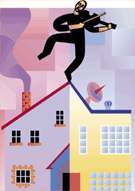Fiddlin` with the future
 We were changing. A president had been shot before our very eyes. War was breaking out in a place called Vietnam. Civil rights workers were being killed in Mississippi. People were marching and protesting and pushing the boundaries of life as we knew it.
We were changing. A president had been shot before our very eyes. War was breaking out in a place called Vietnam. Civil rights workers were being killed in Mississippi. People were marching and protesting and pushing the boundaries of life as we knew it. As the `60s unfolded, along came a musical that captured this turmoil - and became a timeless portrait of the tension between tradition and change. We were the milkman Tevye, arguing with ourselves and our God over when it was right to hold on and when to let go. We were the daughters and their suitors, pushing for new ways to be a part of this world. Never mind that they were from another era and another place. Our lives, just like now, had become as shaky as a fiddler on the roof.
Even before it opened on Broadway in 1964, the creators of "Fiddler on the Roof" knew they were dealing with a universal message.
Sheldon Harnick, who wrote the song lyrics to Jerry Bock`s music, credits the play`s director, the late Jerome Robbins, with honing that theme. In a series of production meetings, Robbins asked the same question: What is this show about? Each time, the others in the room would reply that it`s about a poor Jewish milkman and his wife and daughters living in czarist Russia in the early 1900s.
"Jerry would say, `No, that`s the plot. It`s got to be about something more than that. Otherwise, the story will not have the force that it needs,`" says Harnick. "Finally, one day, somebody said at one of those meetings, `You know what this show is about? It`s about the disintegration of tradition. It`s about the changes of a way of life.` Jerry Robbins lit up and said, `That`s right. That`s what it is.`"
And so from the opening number of "Tradition" to the closing scene of the village`s exodus to new worlds, "Fiddler on the Roof" staged a story for the ages, a universal tale of how old ways change and new ones are born.
In the play, the family was a metaphor for these changes. Tevye, the father, was forced to confront modernity through the lives of his oldest daughters, who wanted to pick their own husbands, rather than have him arrange their marriages. He bent and he bent, until he thought he could bend no more. Until, as he puts it, there could be no "on the other hand."
For an audience perched at the crossroad of uncertainty, "Fiddler on the Roof" was prophetic. Sons would burn draft cards. Daughters would demand liberation. Establishment would become something not to be trusted.
"It was a transitional period, I think, nationally and internationally," says "Fiddler on the Roof" writer Joseph Stein, who took the Yiddish stories of author Sholom Aleichem and fashioned them into the book for this play and subsequent movie.
Stein remembers when "Fiddler on the Roof" went to Japan. The Japanese producer asked him if audiences understood this play in America. Taken aback, Stein asked him what he meant. It`s so Japanese, the producer told him.
Just like in America, Japan`s generations were locked in turmoil, as parents and children faced off over their traditions and an entire nation strained to break out of the aftermath of World War II.
POWER OF LOVE
For lyricist Harnick, the play`s underlying message is about how love is the bridge over these troubled waters.
"That`s the motivating force in Tevye`s life," he adds. "Each time one of the children breaks with tradition, each time it`s his love for his daughters that allows him to take a step forward."
Even when Tevye cannot give his blessing, when a daughter marries outside the faith, he finds a way to send a cryptic message of love.
Harnick says a woman told him once how her estranged father had gone to see the play and then went home and called her. They reconciled. That story has stuck with Harnick over the decades; a testimony to the power of this story.
For writer Stein, it`s the power of tradition that lingers in his memory nearly a half-century after he wrote the first scenes.
"The breaking up of a tradition is a breaking of a society," he says. "Tradition holds a society and a people together."
Yes, Tevye changes, Stein adds. "But he stays within his essential tradition, which is his relationship with his God. A certain core belief is vital to living a healthy and decent life."
What about the value of trying something new?
"If we go with the change just for the sake of change, it`s a major mistake," he says. "But change can also reflect growth. It can be healthy."
The Broadway play ran until July 2, 1972, completing 3,242 performances. It remains the ninth longest-running musical on Broadway. Over the years, it`s been performed in more than 30 countries and is a staple in community theaters and on high school stages.
Still today, touring companies pack in audiences who come to hear the award-winning music and be immersed in a timeless story.
"I think it`s very universal," says Sammy Dallas Bayes, who danced in the original play and directed the recent production at the San Diego Civic Theatre. "The human aspect is still the same as it is today."
By now this human aspect is as predictable as sunrise and sunset: Parents argue with their children, children push the boundaries, and tradition butts heads with change. Which one prevails?
"It`s not one winning and one losing," says Bayes. "Tradition still remains, but it takes on a new shape."
ANCIENT STRUGGLE
Observers of public behavior know why "Fiddler on the Roof" endures and endears.
"I think the popularity precisely is that everyone and every family, in their own way, is going through this kind of struggle," says Gordon Clanton, who teaches sociology at San Diego State University.
Religion is another example where this tension continues to fester, says Clanton, who launches into a brief history - from the clashes in the Bible to the culture wars of today.
"That`s why I think this story is so compelling," he adds. "It`s an artfully told version of an ancient struggle."
For the Rev. William Willimon, dean of the chapel at Duke University in N.C., a fool and his tradition are soon parted. Since 1989, Willimon has watched students come and go from his chapel, yearning for the kind of direction forged from heritage. What is the value of tradition?
"It links us to the dead," says Willimon. "We don`t have to reinvent the wheel, morally speaking."
He adds: "One thing tradition gives us is that it makes us smarter than we would be if left to our own devices."
But Orlando Espin, a professor of theology at the University of San Diego, says that it is the nature of traditions that they must change - or they will die.
"Circumstances change," Espin explains. "The world changes. Cultures change. Individuals change. If a tradition is going to survive meaningfully, it has to make sense in the future, which by definition is different than the past."
But it`s a gradual shift, sometimes taking several generations. It`s only in hindsight, as we look back, that we notice the differences.
Change is good for us, he suggests.
"It is when we stop adapting that we`re risking death."
Things are never the same. Our sons and daughters come home with pierced body parts and clothes that look nothing like what we used to wear. There is fresh music and unfamiliar ways to worship and novel technology that delivers the world in a few keystrokes.
Tevye the milkman strokes his graying beard and tells his wife, "It`s a new world, Golde. A new world."
(c) Copley News Service
advertisement

Author: Sandi Dolbee
Archives
Van Gogh and Gauguin together again
Harry`s Here
Memoir recalls courtship in Dachau
Mr. Smith goes to Hollywood
Moises Kaufman
And now ... the rest of the story
Finally, a time for Grandma
Homing in on Homer`s distinctly American flair
Gidget is back, and she`s original
Ego tours: rock and roles
Springtime for Brooks
The cradle does rock
Behind their music
Fluid approach to architecture is hallmark of modernist
New American plays mirror transitional theme
More Articles







